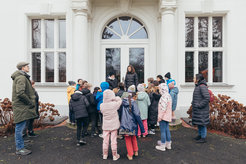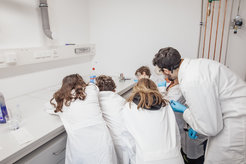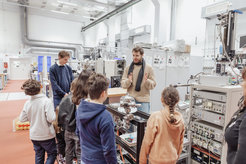Elementary School Children Discover the World of Science
The Interface Science and Inorganic Chemistry Departments at the Fritz Haber Institute of the Max Planck Society had the pleasure of welcoming two fourth-grade classes from the Joan-Miró School. Over two days, the young students immersed themselves in the fascinating world of science and gained insight into the work of our renowned research institute.
An Exciting Program for Young Explorers

On each of the two days, a class of approximately 26 fourth-grade (9-10 year old) students visited the institute. Accompanied by their teachers, they were guided through the labs and the institute by Prof. Beatriz Roldán Cuenya, the Managing Director and Director of the Interface Science Department. This one-hour tour provided the children with some overview of the history of the institute an initial impression of how scientific research is conducted and the role that highly sophisticated laboratories play in this process.
Interactive Stations
After the institute and joint lab tour, the children were divided into four groups, each named after a chemical element: Hydrogen, Carbon, Nitrogen, and Oxygen. Each group experienced four exciting stations.

- Chemistry: Experiments illustrating chemical transformations with emphasis on catalytic processes.
- Physics: Practical demonstrations of physical principles and technologies, with emphasis on vacuum-related science and experiments carried out at cryogenic temperatures.
- Renewal energy show: An entertaining and educational show with demonstrations of CO2-induced climate change, how to generate renewable energy and its use. The latter included the demonstration of the principles of operation of fuel cells and green hydrogen production from water.
- Optical and Electron Microscopy: Introduction to the world of the microcosm through cutting-edge microscopy technology.
Bilingual Learning
The school who visited us was a public Europe school with a German-Spanish bilingual program. Due to the international nature of our research department, we were able to offer our entire scientific program in both, German and Spanish to provide the children with an inclusive learning experience. This also served to demonstrate the international nature of the scientific research.
Conclusion: Inspiring a Passion for Science

The aim of this event was to spark the children's interest in science, particularly in physics and chemistry, and to show them how research works. We hope that these days of curiosity and discovery have inspired the young participants and perhaps laid the foundation for future scientists.
We would like to extend our heartfelt thanks to all our colleagues who meticulously prepared and organized this event, ensuring its success. Their dedication and enthusiasm made this enriching experience possible for the young students.
The Fritz Haber Institute looks forward to continuing to inspire young people in science and opening the doors to research for them in the future.
These are some “Thank You Notes” from the Children to the Fritz Haber Institute.


















